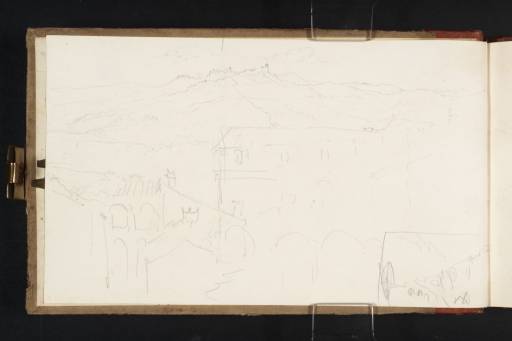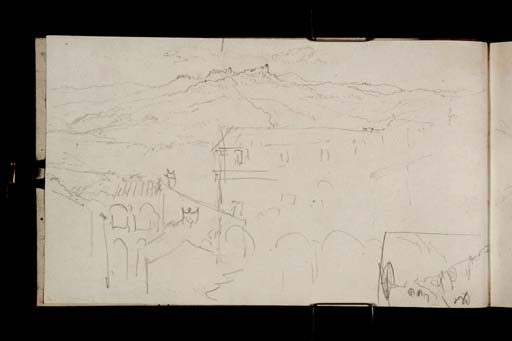Joseph Mallord William Turner Castel Fidardo and Osimo from the Walls of Loreto 1819
Image 1 of 2
Joseph Mallord William Turner,
Castel Fidardo and Osimo from the Walls of Loreto
1819
Joseph Mallord William Turner 1775–1851
Folio 1 Verso:
Castel Fidardo and Osimo from the Walls of Loreto 1819
D14654
Turner Bequest CLXXVII 1 a
Turner Bequest CLXXVII 1 a
Pencil on white wove paper, 110 x 186 mm
Accepted by the nation as part of the Turner Bequest 1856
References
1909
A.J. Finberg, A Complete Inventory of the Drawings of the Turner Bequest, London 1909, vol.I, p.520, as ‘At Loreto (?)’.
1982
Evelyn Joll and Martin Butlin, L’opera completa di Turner 1793–1829, Classici dell’arte, Milan 1982, p.[120] under no.331.
1984
Martin Butlin and Evelyn Joll, The Paintings of J.M.W. Turner, revised ed., New Haven and London 1984, p.185 under no.331.
After a sustained period of travel along the east coast from Rimini, Turner’s route turned inland and began to follow the south-westerly course towards Rome. Beyond Ancona the first major stopping place of note was Loreto, a famous site of Catholic pilgrimage due to the legendary Holy House, or house of the Madonna, preserved within the Church of the Santuario della Santa Casa. Turner made a number of sketches both on the approach to Loreto, and of the town itself, see folio 10 (D14671). Owing to its hilltop location, the encircling fortified walls offered impressive views overlooking the surrounding countryside and the Adriatic sea. This sketch depicts the distant towns of Castel Fidardo and Osimo as seen from a point near the Porta Romana, on present-day Corso Traiano Boccalini. The buildings visible in the foreground still exist today, framing the panorama looking north-west over the valley of the Musone.
The view from Loreto’s walls was a popular one with British travellers touring Italy. Turner’s notes in the Italian Guide Book sketchbook (see Tate D13939; Turner Bequest CLXXII 4a) reveal that he was familiar with John Chetwode Eustace’s description in A Classical Guide to Italy:
The distance from Ancona to Loretto, is about fourteen miles; the road hilly, the country in the highest degree fertile, and the views on every side extremely beautiful ... Loretto also is situate on a very bold and commanding eminence ... It is surrounded with a rampart, and from that rampart commands a varied and most delightful prospect on all sides. To the north rise Osimo the Auximom of the ancients, and Camurano, each on a lofty hill ... on the south, Monte Santo anciently Sacrata, and Macerata; to the west, Recanati, and Monte Fiore; with the Apennines rising, broken, white and craggy, behind; while to the east, between two hills, the Adriatic spreads its blue expanse, and brightening as it retires from the shore, vanishes gradually in the white fleecy clouds that border the horizon.1
He may also have seen James Hakewill’s drawing of the same subject, Castel Fidardo and Ossimo from the Walls of Loreto 1817 (Library of the British School at Rome), which records the same topographical outline in greater detail.2
In the bottom right-hand corner of the page is a separate sketch. Its schematic nature makes identification difficult but it possibly depicts a view of the aqueduct which lies between Loreto and Recanati, see folio 16 (D14683).
Nicola Moorby
November 2008
How to cite
Nicola Moorby, ‘Castel Fidardo and Osimo from the Walls of Loreto 1819 by Joseph Mallord William Turner’, catalogue entry, November 2008, in David Blayney Brown (ed.), J.M.W. Turner: Sketchbooks, Drawings and Watercolours, Tate Research Publication, December 2012, https://www


